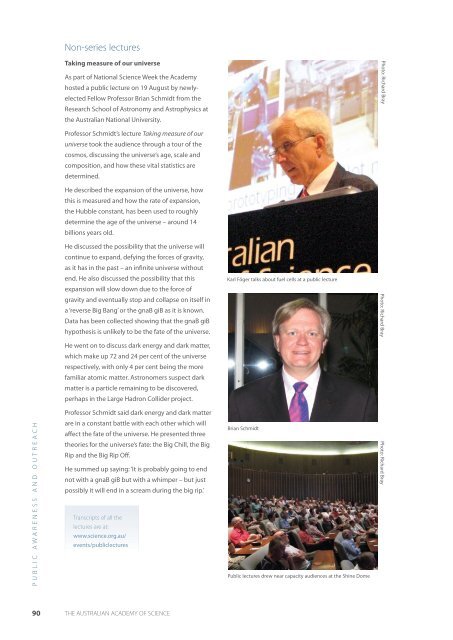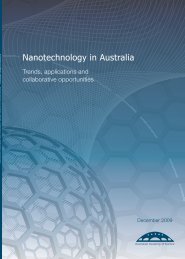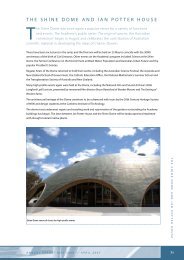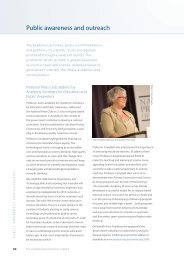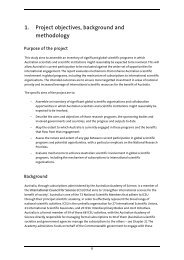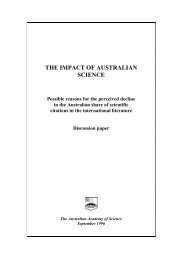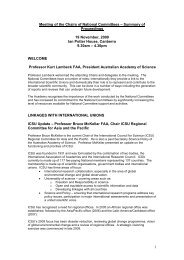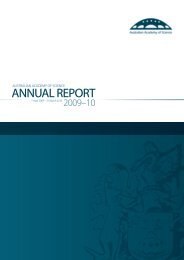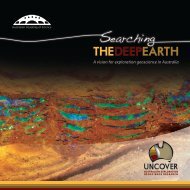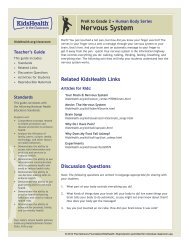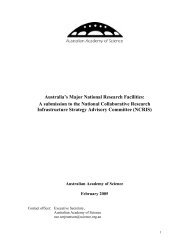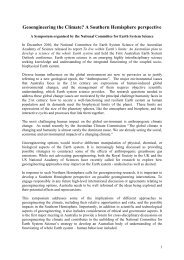full report - Australian Academy of Science
full report - Australian Academy of Science
full report - Australian Academy of Science
Create successful ePaper yourself
Turn your PDF publications into a flip-book with our unique Google optimized e-Paper software.
Non-series lectures<br />
Taking measure <strong>of</strong> our universe<br />
As part <strong>of</strong> National <strong>Science</strong> Week the <strong>Academy</strong><br />
hosted a public lecture on 19 August by newlyelected<br />
Fellow Pr<strong>of</strong>essor Brian Schmidt from the<br />
Research School <strong>of</strong> Astronomy and Astrophysics at<br />
the <strong>Australian</strong> National University.<br />
Photo: Richard Bray<br />
Pr<strong>of</strong>essor Schmidt’s lecture Taking measure <strong>of</strong> our<br />
universe took the audience through a tour <strong>of</strong> the<br />
cosmos, discussing the universe’s age, scale and<br />
composition, and how these vital statistics are<br />
determined.<br />
He described the expansion <strong>of</strong> the universe, how<br />
this is measured and how the rate <strong>of</strong> expansion,<br />
the Hubble constant, has been used to roughly<br />
determine the age <strong>of</strong> the universe – around 14<br />
billions years old.<br />
He discussed the possibility that the universe will<br />
continue to expand, defying the forces <strong>of</strong> gravity,<br />
as it has in the past – an infinite universe without<br />
end. He also discussed the possibility that this<br />
Karl Föger talks about fuel cells at a public lecture<br />
expansion will slow down due to the force <strong>of</strong><br />
gravity and eventually stop and collapse on itself in<br />
a ‘reverse Big Bang’ or the gnaB giB as it is known.<br />
Data has been collected showing that the gnaB giB<br />
hypothesis is unlikely to be the fate <strong>of</strong> the universe.<br />
Photo: Richard Bray<br />
He went on to discuss dark energy and dark matter,<br />
which make up 72 and 24 per cent <strong>of</strong> the universe<br />
respectively, with only 4 per cent being the more<br />
familiar atomic matter. Astronomers suspect dark<br />
matter is a particle remaining to be discovered,<br />
perhaps in the Large Hadron Collider project.<br />
Pr<strong>of</strong>essor Schmidt said dark energy and dark matter<br />
PUBLIC AWARENESS AND OUTREACH<br />
are in a constant battle with each other which will<br />
affect the fate <strong>of</strong> the universe. He presented three<br />
theories for the universe’s fate: the Big Chill, the Big<br />
Rip and the Big Rip Off.<br />
He summed up saying: ‘It is probably going to end<br />
not with a gnaB giB but with a whimper – but just<br />
possibly it will end in a scream during the big rip.’<br />
Transcripts <strong>of</strong> all the<br />
lectures are at:<br />
www.science.org.au/<br />
events/publiclectures<br />
Brian Schmidt<br />
Public lectures drew near capacity audiences at the Shine Dome<br />
Photo: Richard Bray<br />
90<br />
THE AUSTRALIAN ACADEMY OF SCIENCE


